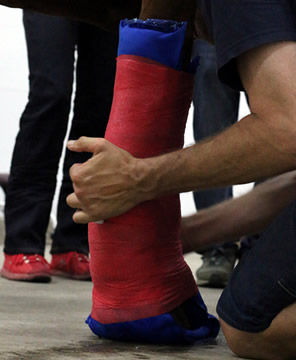Splints
Immobilisation of legs and joints can be an important tool in the veterinary management of fractures of bony structures, tendon and ligament tears or ruptures, sutured full-thickness wounds, laminitis or other problems in the horse’s foot. Applying bandages with splints or casts is not really daily business for the most equine vets. However, in emergency situations proper immobilisation directly at the onset of the insult at the location where it took place can make a huge difference for the outcome of further treatment hence, the future career of the (sport)horse. Therefore, a splint that is easy to apply and mould to different parts of the leg or the whole leg, on a standing- or recumbent horse with enough strength and support will be a valuable tool for equine vets. The DJM Performance Multi-Purpose Wonder Splint has it all. It can be readily available together with some adhesive bandages in any vet truck in a flexible sealed bag, only needs some air and water to harden and provides rigid support and protection on the spot.
Characteristics
-
Fiberglass splint outside, modelling cushion on the inside in one lining
-
Follows perfectly the contours of leg and foot
-
Rigid through both fiberglass and cushion setting in 20 minutes
-
No pressure from fiberglass on skin or underlying structures through integrated protective and modelling cushion, no rims or pressure sores
-
Can be applied to both standing and recumbent horse and horses
-
Cushion is breathable material
-
Cushion can be rinsed and cleaned
-
Cushion gives support to soft tissues and when simultaneously applied under the foot also functions as a Sole Support
-
Fast and correct application also in the standing horse
-
Easy to take for sport-horse medicine and emergencies on site
-
Size and shape specifically designed for the use in horses
-
When used for immobilisation of wounds on or near joints, easy to remove and reapply
DJM Splints are Essential Support for
-
Bone fractures and fissures in limbs and foot
-
Tendon and ligament tears or ruptures
-
Laminitis
-
Immobilisation as essential part of wound management
-
Transportation of horses with acute lameness of unknown origin
DJM Splints Product Code : DJMSPL001
-
Small 10cm Wide x 50cm Long
-
Medium 12.5cm Wide x 75cm Long
-
Large 15cm Wide x 100cm Long
Splints Typical Application
1.
Open from the end and 1/4 fill with water, making Sure the water touches the entire splint. (Or you can pull the splint out of the bag and sprinkle with water.)
This will accelerate the curing time.
2.
Place the splint on the ground with the blue cross on top, to be sure the soft side is applied to the limb. position the horse's foot centrally on the Splint, using the cross as a guide.
3.
Once the horse is bearing full load on the splint, bring each side up behind and in front of the limb, molding it so it is even and a close fit.
4.
With a cohesive bandage, start at the lower end of the limb, working your way up to the top of the splint, using firm pressure to apply the bandage.
5.
Once bandaging is complete the horse can be put into a stable to recover.
6.
The splint can be removed, as needed, to manage the wound. wash the splint, using warm salty water, it can then be reapplied and re-bandaged.

Splints Typical Application
Equine practitioners are not often faced with situations where a splint is needed. However, when the moment is there it’s an emergency and action has to be taken immediately. Splints are needed when there is a suspicion of a fissure, or fracture in the lower limb and horses have to be taken to a hospital for further investigation. You do not want the situation to become worse when horses travel and after diagnosing a fissure or fracture immobilization using a cast or splint is often part of the treatment. Another reason for using a splint are wounds near joints where immobilisation of the joint is needed to prevent movement of the wound surface and traction to the wound rims. This enhances the healing process and in case of secondary wound healing prevents an over production of proud flesh.
Having the right materials available on the spot when these problems occur is not easy. You do not want to travel with a lot of stuff in your car or have your store in the clinic packed with materials in different sizes for different horses and situations. The DJM Performance Splint comes in a package that’s well protected and can be stored easily in an equine ambulatory practice vehicle or at a store room.
The DJM Performance Splint is moulded to the shape of the injured leg and fits every horse perfectly well. Because of the inside, made of soft and breathable polystyrene, the skin is protected from pressure sores and provides a comfortable support. The perfect fit also limits the movement of the joint or other parts of the leg. This is kept in place by the fiberglass lining on the outside of the splint, also shaped to the leg but not in direct contact with the skin. Rims, sometimes originating in this more rigid and supportive material, remain on the outside, and do not cause pressure sores on the skin or other underlying tissues.
When applied to the leg the DJM Performance splint takes 5 – 20 minutes to set, depending on how much water is supplied and the environmental temperature. During the setting of the splint it can be moulded to the foot. Any bandage can be used to keep the splint in place. Using a more rigid and strong bandage (i.e. Maxi Wrap compared too cohesive) will make the splint stronger and keep it better in place.
The splint can be reapplied on the same leg after a bandage change. The material is washable and breathable.







